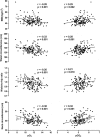The relationship between anthropometric measures, blood gases, and lung function in morbidly obese white subjects
- PMID: 21086061
- PMCID: PMC3058403
- DOI: 10.1007/s11695-010-0306-9
The relationship between anthropometric measures, blood gases, and lung function in morbidly obese white subjects
Abstract
Background: Obesity may cause adverse effects on the respiratory system. The main purpose of this study was to investigate how various measures of obesity are related to arterial blood gases and pulmonary function.
Methods: This is a cross-sectional study of consecutive morbidly obese patients with normal lung function. Blood gas samples were taken from the radial artery after 5 min of rest with subjects sitting upright. Lung function measurements included dynamic spirometry, static lung volumes, and gas diffusing capacity.
Results: The 149 patients (77% women) had a mean (SD) age of 43 years (11 years) and BMI of 45.0 kg/m(2) (6.3 kg/m(2)). The mean expiratory reserve volume (ERV) was less than half (49%) of predicted value, whilst most other lung function values were within predicted range. Forty-two patients had an abnormally low pO2 value (<10.7 kPa [80 mmHg]), while eight patients had a high pCO2 value (>6.0 kPa [45 mmHg]). All anthropometric measures correlated significantly with decreasing pO2 and increasing pCO2 (all P values < 0.05). BMI, neck circumference (NC), and waist circumference (WC) were negatively correlated with ERV (r = -0.25, -0.19, -0.21, respectively, all P values < 0.05). Multiple linear regression showed that BMI, WC, and NC were significantly associated with pO2 after adjustments for age, gender, and pack-years (all P values < 0.001). The models explained 34-36% of the variations in pO2. BMI, NC, and WC were also significantly associated with pCO2 (all P values < 0.05).There was no significant association between waist-to-hip ratio and blood gases (both P values > 0.27).
Conclusions: Both central and overall obesity were associated with unfavorable blood gases and low ERV.
Conflict of interest statement
No potential conflicts of interest relevant to this article were reported.
Figures
Similar articles
-
The effects of obesity on lung volumes and oxygenation.Respir Med. 2017 Mar;124:15-20. doi: 10.1016/j.rmed.2017.01.004. Epub 2017 Jan 18. Respir Med. 2017. PMID: 28284316
-
Pulmonary gas exchange in the morbidly obese.Obes Rev. 2008 Jul;9(4):326-39. doi: 10.1111/j.1467-789X.2008.00471.x. Epub 2008 Mar 4. Obes Rev. 2008. PMID: 18331421 Review.
-
Surgically induced weight loss, including reduction in waist circumference, is associated with improved pulmonary function in obese patients.Surg Obes Relat Dis. 2011 Sep-Oct;7(5):599-604. doi: 10.1016/j.soard.2011.04.221. Epub 2011 Apr 19. Surg Obes Relat Dis. 2011. PMID: 21689991
-
Respiratory function in the morbidly obese before and after weight loss.Thorax. 1989 May;44(5):382-6. doi: 10.1136/thx.44.5.382. Thorax. 1989. PMID: 2503905 Free PMC article.
-
Impact of obesity on pulmonary function: current understanding and knowledge gaps.Curr Opin Pulm Med. 2021 Mar 1;27(2):132-140. doi: 10.1097/MCP.0000000000000754. Curr Opin Pulm Med. 2021. PMID: 33394747 Review.
Cited by
-
Adiposity markers and lung function in smokers: a cross-sectional study in a Mediterranean population.BMC Pulm Med. 2016 Dec 9;16(1):178. doi: 10.1186/s12890-016-0341-y. BMC Pulm Med. 2016. PMID: 27938399 Free PMC article. Clinical Trial.
-
Obesity, Anion Accumulation, and Anion Gap Metabolic Acidosis: A Cohort Study.Kidney360. 2021 Sep 9;2(11):1706-1715. doi: 10.34067/KID.0003562021. eCollection 2021 Nov 25. Kidney360. 2021. PMID: 35372994 Free PMC article.
-
Effect of body weight loss on cardiopulmonary function assessed by 6-minute walk test and arterial blood gas analysis in obese dogs.J Vet Intern Med. 2014 Mar-Apr;28(2):371-8. doi: 10.1111/jvim.12260. Epub 2013 Dec 18. J Vet Intern Med. 2014. PMID: 24351032 Free PMC article.
-
Sleep study, respiratory mechanics, chemosensitive response and quality of life in morbidly obese patients undergoing bariatric surgery: a prospective, randomized, controlled trial.BMC Surg. 2011 Oct 17;11:28. doi: 10.1186/1471-2482-11-28. BMC Surg. 2011. PMID: 22004426 Free PMC article. Clinical Trial.
-
The Relationship between Serum Uric Acid Levels and Early Mortality in Chronic Obstructive Pulmonary Disease Cases during Exacerbation.Sarcoidosis Vasc Diffuse Lung Dis. 2022;39(2):e2022014. doi: 10.36141/svdld.v39i2.12127. Epub 2022 Jun 29. Sarcoidosis Vasc Diffuse Lung Dis. 2022. PMID: 36118541 Free PMC article.
References
-
- Naimark A, Cherniack RM. Compliance of the respiratory system and its components in health and obesity. J Appl Physiol. 1960;15:377–82. - PubMed
-
- Kress JP, Pohlman AS, Alverdy J, et al. The impact of morbid obesity on oxygen cost of breathing (VO(2RESP)) at rest. Am J Respir Crit Care Med. 1999;160:883–6. - PubMed
MeSH terms
Substances
LinkOut - more resources
Full Text Sources



